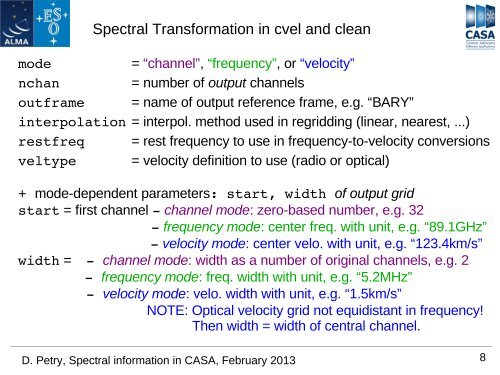Spectral information in CASA - ESO
Spectral information in CASA - ESO
Spectral information in CASA - ESO
You also want an ePaper? Increase the reach of your titles
YUMPU automatically turns print PDFs into web optimized ePapers that Google loves.
<strong>Spectral</strong> Transformation <strong>in</strong> cvel and clean<br />
mode = “channel”, “frequency”, or “velocity”<br />
nchan = number of output channels<br />
outframe = name of output reference frame, e.g. “BARY”<br />
<strong>in</strong>terpolation = <strong>in</strong>terpol. method used <strong>in</strong> regridd<strong>in</strong>g (l<strong>in</strong>ear, nearest, ...)<br />
restfreq = rest frequency to use <strong>in</strong> frequency-to-velocity conversions<br />
veltype = velocity def<strong>in</strong>ition to use (radio or optical)<br />
+ mode-dependent parameters: start, width of output grid<br />
start = first channel channel mode: zero-based number, e.g. 32<br />
frequency mode: center freq. with unit, e.g. “89.1GHz”<br />
velocity mode: center velo. with unit, e.g. “123.4km/s”<br />
width = channel mode: width as a number of orig<strong>in</strong>al channels, e.g. 2<br />
frequency mode: freq. width with unit, e.g. “5.2MHz”<br />
velocity mode: velo. width with unit, e.g. “1.5km/s”<br />
NOTE: Optical velocity grid not equidistant <strong>in</strong> frequency!<br />
Then width = width of central channel.<br />
D. Petry, <strong>Spectral</strong> <strong><strong>in</strong>formation</strong> <strong>in</strong> <strong>CASA</strong>, February 2013<br />
8
















